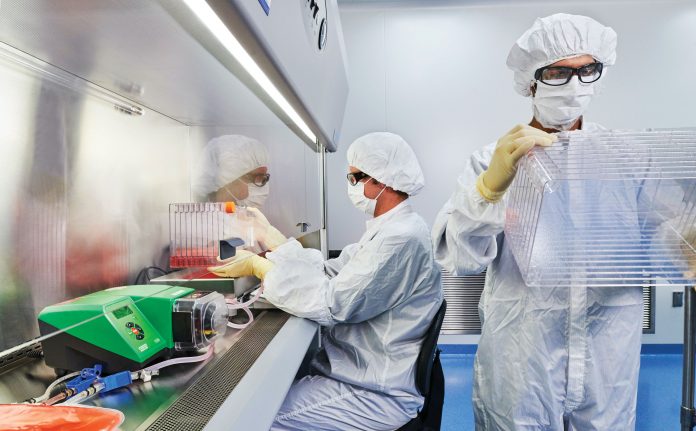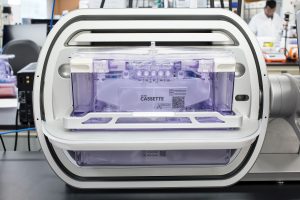
The global market for treatments based on cells or genes is supposedly set to explode. According to a report released last year by BIS Research, this market will reach a value of $8.95 billion by 2025, growing at a compound annual growth rate of 36.52% from a 2018 value of $1.07 billion.
Before we let figures such as these impress us too much, we should remember that the market is still new. No gene-based therapy received FDA approval until 2017, when the agency deemed Kymriah to be safe and effective against acute lymphoblastic leukemia. The cell and gene therapy market, like any emerging market, should be expected to experience growing pains.
In the cell and gene therapy market, the biggest growing pain is the need to keep up with the demand for viral vectors, which are used to carry genetic materials to host cells. Although viral vectors are crucial components in the manufacture of most kinds of cell and gene therapy, they have a history of supply problems.
In 2017, Gina Kolata wrote in the New York Times that gene therapy companies were “struggling to obtain” viral vectors. The editors at GEN wondered if a viral vector shortage still existed, and they sent me to find out.
One of my first moves was to consult Alberto Santagostino, head of cell and gene technologies at Lonza in Basel, Switzerland. He offered some encouragement, saying the market had “moved on” since 2017. But he also sounded a cautionary note: “If someone wants a batch for the day after tomorrow, that’s unlikely.” These statements suggest that the shortage question is really about expectations. Which expectations, then, are likely to be met?
Current capacity
When asked if Kolata’s statement remains accurate, Jerry Keybl, PhD, head of cell and gene therapy manufacturing at MilliporeSigma, answered, “Yes, viral vector manufacturing capacity shortages are still a challenge.” The same question was addressed to Hanna P. Lesch, PhD, the gene therapy unit director at the Kuopio Center for Gene and Cell Therapy in Finland. She said, “All experienced contract manufacturing organizations (CMOs) are fully booked.” She also indicated that the shortage in manufacturing capacity is “a generally known situation.”
According to Keybl, taking cell and gene therapies to the industrial scale poses two major challenges: plasmid supply and virus. “We are dealing with technologies developed in the 1970s,” he pointed out. “Although the science has advanced, the industry is still using manufacturing technologies that are 30 years old.”

Plus, some things can be scaled up more easily than others. A company might make an adeno-associated virus (AAV) in a 2000-L vessel but work on a smaller scale when making plasmids. “We’ve only scaled AAV production via three-plasmid transfection to 500 L,” observed Steven Pincus, PhD, head of science and innovation at Fujifilm Diosynth Biotechnologies Texas in College Station.
Essentially, the challenge for viral components of cell and gene therapy arises from demand exceeding supply. Here, though, it’s not just that too few companies make the viruses. There are, in Keybl’s view, two drivers: insufficient capacity for manufacturing viral vectors, and inadequate processes. The lack of industrialized processes leads to low yields and too many batch failures.
Diverse difficulties
How much of a shortage a biotechnology or pharmaceutical company might face in developing a new treatment will depend on the disease. If it’s a low-prevalence disease, that’s less of a problem. “We can meet the demands of a disease where there’s maybe 100 patients a year,” Pincus said. “If you want to treat thousands, it will be quite a challenge to make doses. It may take six months to make enough. And if that treatment is successful, it could tie up our whole site.”
In fact, many CMOs only work on research or clinical-trial levels. As Pincus noted, “Lots of CMOs don’t do commercial.” So, some companies might decide to manufacture things on their own. “Doing that—getting building permits, getting the right design, getting it built—will take maybe five years,” he elaborated. “It could take months just to get stir tanks.” That sounds like enough problems with time, but there are more.
Slow starts
Once a company does connect with a CMO, timing remains an ongoing problem. “From the start of a CMO project until the generation of a viral vector product takes about a year and a half, depending on client timeline and budget,” estimated Kassim Kolia, head of business development at FinVector, a CMO in Kuopio, Finland. “The majority—about 90%—of our clients don’t come to us with a scalable process.” So, Kolia and his colleagues need to help the client develop a method of making the needed virus, select a good manufacturing practice (GMP)-compliant cell line, pick a platform that can be used in pilot studies and in later GMP manufacturing, and so on.

Other experts also pointed out that timing plays a key role. At Lonza, Santagostino said that getting a production slot for viral vectors is usually possible in six to nine months. He added, “We can offer capacity for most needs within 12 months.”
The timing constraints go even further. “Certain vector-specific disposable materials may have months of delivery time,” warned Lesch. “So, worst case, we spend time waiting for material to arrive.”
Beyond waiting for materials, companies often need to wait for people—personnel to work in the virus-manufacturing companies. It’s difficult to find people with experience, and even then, Lesch continued, “every person needs to be trained in-house for our processes.”
Kolia agreed that recruiting enough qualified people poses a challenge: “If we need people, it takes three months until the first one starts, and it six months of training before they are at all independent working in our clean room.”
Recruitment is a challenge even when CMOs are advantageously sited. Consider the example of Fujifilm Diosynth Biotechnologies Texas. This CMO is situated on the campus of Texas A&M University amongst more than 50,000 students, and it occupies the same building as the university’s National Center for Therapeutics Manufacturing. Yet, as Pincus remarked, “It’s difficult to get people with experience, especially to be supervisors.”
Intelligent investments
The viral vector shortage is a multifaceted problem, and it is being addressed from several angles. For example, at MilliporeSigma, Keybl and colleagues are focusing on culture conditions. “Viral vector manufacturing yields are dependent upon the amount of surface area available for vector-producing cells to grow on,” Keybl says. To solve this problem, MilliporeSigma has developed vector-producing cell lines, called VirusExpress cell lines, that can be used in suspension. “Rather than having to scale out the number of flatbed flasks, we will be able to manufacture viral vectors in bioreactors,” asserted Keybl. “[Our approach] will help address the scale challenges facing the industry.”
More or bigger facilities are also needed. “Companies are investing in building manufacturing now,” Kolia noted. “Maybe in five years, capacity might be a different story.”
Creating tomorrow’s new story, though, depends on starting now. “At Fujifilm Diosynth Biotechnologies Texas,” Pincus said, “we’re expanding our capabilities by adding more facilities.” He added that he and his colleagues are also asking what they can do “in terms of evaluating new technologies.”
Other companies are also expanding their capabilities to ensure viral supply. In 2019, clinical-stage biotechnology company Regenxbio began constructing a production facility in Rockville, MD. This facility should be operational in 2021.
According to Curran M. Simpson, the company’s senior vice president of product development and chief technology officer, the facility will make viral vectors “at bioreactor scales, up to 2000 L, using our platform suspension cell culture process, allowing us to more efficiently advance development programs from research stage to the clinic.”
“Importantly, the manufacturing facility will allow for concurrent production of multiple gene therapy vectors,” Simpson continued. “The facility will be co-located with process development and analytical teams. This integrated approach will allow for more efficient development, manufacture, and release of vectors for new indications.”
Productive partnerships
CMOs are preparing for the future, and companies hoping to market cell or gene therapies should do the same. “The sooner that we get a client—before they get too immersed in things that won’t work well—we can help get them into scalable processes,” Pincus explained.
Working together might make a big difference. Santagostino said that he and his colleagues at Lonza “are trying to create partnerships with our customers to guide them on the journey that starts before filing an investigational new drug application and continues through commercial stages.”
Plus, a company can gain time and simplify ongoing steps by finding a CMO that can stay the course. “You don’t want to make material for Phase I, show safety and maybe some efficacy, and then change the process to go forward,” Pincus advised.
In brief, both virus manufacturers and treatment developers must start on any project as soon as possible, and also work together at early stages. Even that, however, won’t make it possible to produce lots of a viral vector in short order. Only more facilities and better processes can do that. To meet the predicted demand ahead, everyone must move fast. Ideally, they would have started yesterday.

